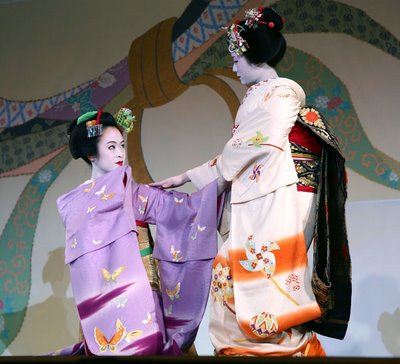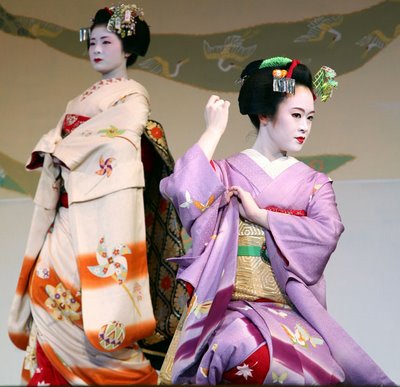Wednesday, April 25, 2007
Miyako Odori: Crepe Facric of Echigo
Sunday, April 22, 2007
Miyako Odori: The Hikone Folding screen
 Commemorating the 400th anniversary of Hikone Castle, the third scene was based on the famous folding screen, once owned by a Hikone Daimyo (feudal lord) from the Ii family. The screen, believed to have been created between 1624 and 1644, is considered one of the best Japanese genre paintings andhas been designated as a national treasure.
Commemorating the 400th anniversary of Hikone Castle, the third scene was based on the famous folding screen, once owned by a Hikone Daimyo (feudal lord) from the Ii family. The screen, believed to have been created between 1624 and 1644, is considered one of the best Japanese genre paintings andhas been designated as a national treasure. The Kabuki Actress: Today, Kabuki is famous for it's lack of actresses, and the peculiar male actors who specialize in portraying women (onnagata). It was a young shrine maiden named Okuni, however, who first began performing the wild new style of dance drama in Kyoto's dry Kamo riverbed in 1603. Female performers portrayed both men and women in comic playlets about everyday, ordinary life. The style was an instant hit, popular with the masses and eventually, nobility. Okuni was invited to perform before the Imperial Court, inspiring the formation of rival troupes in the wake of such success. Much of its appeal was due to the suggestive performances put on by many troupes, further augmented by the fact that the performers were often also available for prostitution. In fact, kabuki was often written with the characters for song, dance, and prostitute during the Edo Period.

The ex-samurai seems to have been very popular...
 A young child of the pleasure quarters (on the right).
A young child of the pleasure quarters (on the right).

Miyako Odori: Prelude
This year's Miyako Odori marked the 135th anniversary of Kyoto's most famous celebration of spring; the colorful spectacle of traditional beauty, draped in silk and framed by scenes of the old capital, painted like elegant hanging scrolls viewed through a delicate vale of pretty pink cherry blossoms. Afraid that the vibrant cultural treasures of the ancient empirial seat would fade and wither when the capital was relocated to Tokyo (during the Meiji Restoration), Kyoto's governors searched for a way to develope and promote the old capital. Inspired by the group performances of Kamenoko Odori in Ise Furuichi, they humbly requested the maiko and geiko of Gion, whose popularity and numbers were at a peak, to present a dance to the public as a side show to a special Expo they would hold at the Imperial Palace. The geiko of Gion had never perofrmed together as a group, but with the help and blessing of the Inoue school of dance, the first Miyako Odori was held in a single room with beautiful sliding doors in a house called Matsunoya (located in Gion Shinbashi). At that time, it was agreed that the dance of Gion Kobu, the most prestigious of Kyoto`s five geisha districts, be the Inoue style of Kyomai (Kyoto's traditional style of dance), and that no other schools of dance be involved.

Beneath the softly veiled light of crimson paper lanters bearing the "tsunagi dango" (linked dumpling) crest of Gion, a curtain rose to reveal a row of maiko and geiko, their faces painted like delicate white clouds in brilliant turqouis blue kimono, raising their hands to hit small drums or gracefully lifting their bamboo flutes to their lips. With a loud call of "Miyako Odori wa Yoiyasa," 20 "Geiko" and "Maiko," traditional Japanese entertainers and their apprentices, appeared one after the other, slowly stepping out onto the hanamichi ("flower paths", runways that line both sides of the theater leading to the stage.) Usually, there are many ways to distinguish a maiko from a geiko: sublte differences in the style of dress, hair, and even make-up, but during certain scenes of Miyako Odori, these distinctions nearly disappear. Regardless of their age or rank, maiko and geiko dance together, all in the extravagant furisode (long sleeved kimono) usually associated with maiko, have their own hair styled (as opposed to geiko wearing wigs) with ornate hair ornaments, and wear their obi tied af half length, a style usually reserved for soon-to-be maiko the month before their debut.
Makiko, a popular young maiko, makes her entrance during the prelude to this year's Miyako Odori, "The Dances of the Old Captial". This year's program was entitled "Miyako Furyu Meisho Emaki," or Picture Scrolls of the Old Capital`s Famous Sights. Each scene of Miyako Odori has an independent story which is newly created every year, including the songs and dances.

The silver sliding doors on the stage represent the room of an ancient court noble's palace where the Inoue style of kyomai, traditional Kyoto dance, was performed during the Edo period. The theater, Gion Kaburenjo, was built especially for Miyako Odori with distinctive architectual features common in Japanese palaces. For this reason it has been designated as a tangible cultural asset of Japan. 
Kotoha (left) , one of my favorite dancers. She has such expressive eyes, which is important in the Inoue school of dance. Heavily influenced by Noh theater, the dancers are meant to perform without any expression whatsoever, as if they were wearing a Noh theater mask. In traditional Japanese culture, the outward expression of any emotion was considered inappropriate. Many people confuse this with sadness on the part of the performers, but this is simply a lack of understanding of traditional Japanese culture.
Saturday, December 16, 2006
Gion Odori 2006: Maneki
 Masayo and Miharu.
Masayo and Miharu.The theme of this year's Gion Odori, the fall dance performed by the maiko and geiko of Gion Higashi, was "Seasonal Glories of the Maiko's Hanakanzashi," or flowered hair ornaments.
 Masayo and Fumiki.
Masayo and Fumiki.In December, maiko wear the maneki hanakanzashi. This dance depicted the maiko attending the year-end debut of Kabuki actors at the Minamiza theater. A young maiko overcomes her shyness to ask her favorite actor for his signature "with her big courage".

Masayo, the highest ranking maiko in Gion Higashi, dancing during the opening act of this year's Gion Odori: Maneki. This years theme was hanakanzashi, the flowered hair ornaments worn by the maiko. Each dance reflected the meaning and seasons in which each hanakanzashi is worn.
During Kaomise (from about Nov.30- Dec. 26) , the names of the performing Kabuki actors are written on long, wooden boards called maneki kanban, and hung outside the theater. Maiko attend the Kaomise (face showing) Kabuki performances, wearing these Maneki hanakanzashi. Two small, blank tags are attatched, and maiko ask their favorite Kabuki actors to sign them afterwards.
Fukimi and Miharu strike a Maneki Neko, or beckoning cat, pose.
Fumiki and Umeha.
Tuesday, November 14, 2006
Misoekai: Miyagawa's Fall Dance
Kimitomo 君友 peeks out demurely from behind her gold-speckled fan. The extravagant silks, colorful kimonos, flowery hair ornaments and hauntingly beautiful make up are only part of a maiko's beauty, and impressive as they are, the true allure lies in her child-like innocence.
As a geiko, Kimina 君奈 no longer relies on the flashy kimonos or ornate hair ornaments. She has attained a level of skill that speaks for itself with every graceful movement.
Harumi 春美
Saturday, July 23, 2005
Gion Matsuri : Yoiyama Kyomai
This is the fruit of my Japanese language labour...I was able to read the kanji foretelling the appearance of Geiko and Maiko performing Kyomai, as well as the names written on their uchiwa! Obsessed as I am, this gave me a great sense of accomplishment and furthur motivated me to press on! Who knows what gems of information are hidden in the kanji that clutter this country (besides the people that can read them)? Let's fighting ganbaro!
Stay tuned...more Matsuri Maiko pix to come...
Check out Justin Klien's Gion Matsuri Video to get a better idea of what this festival is all about!















